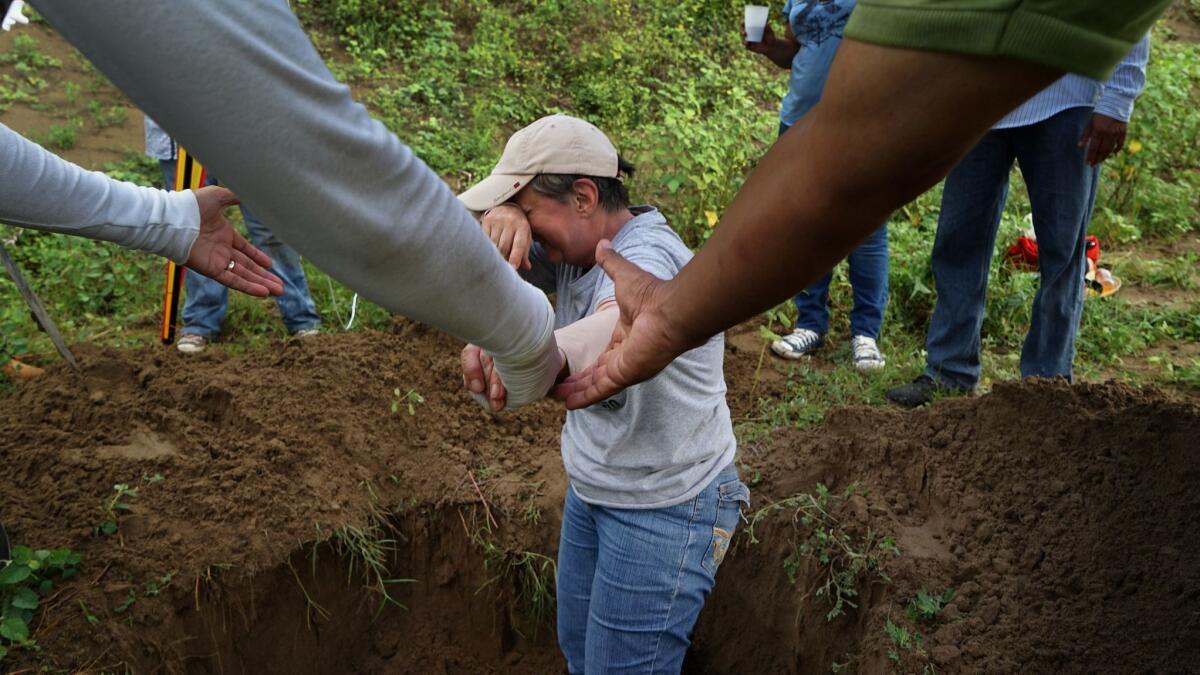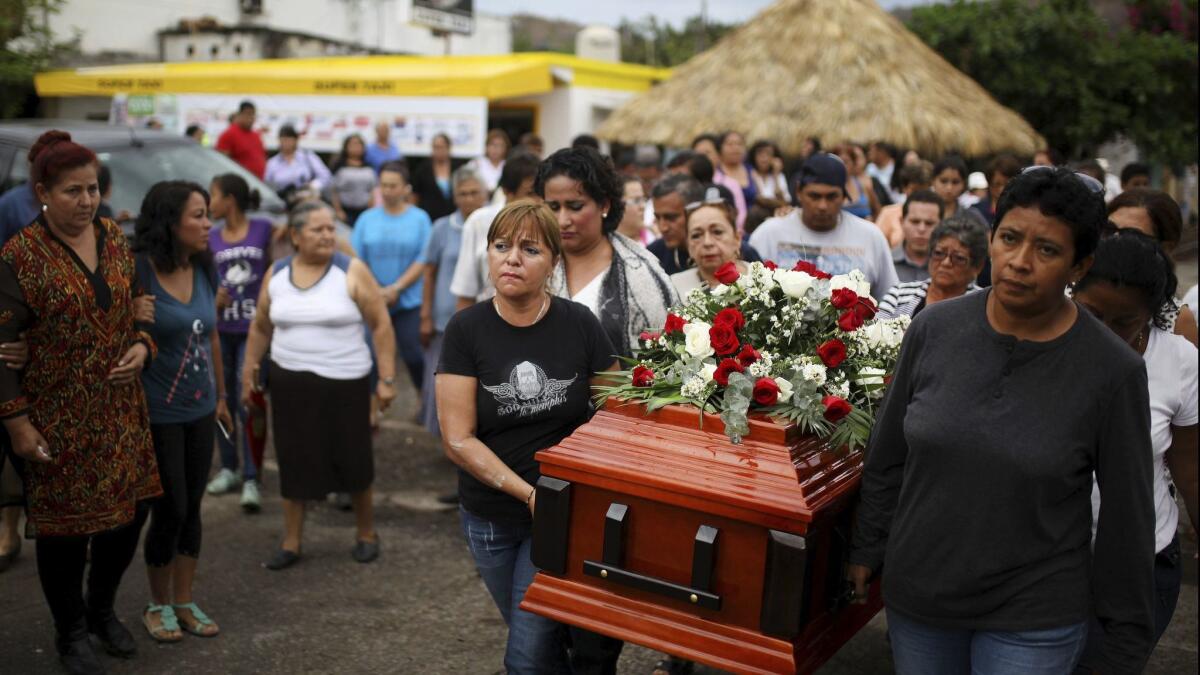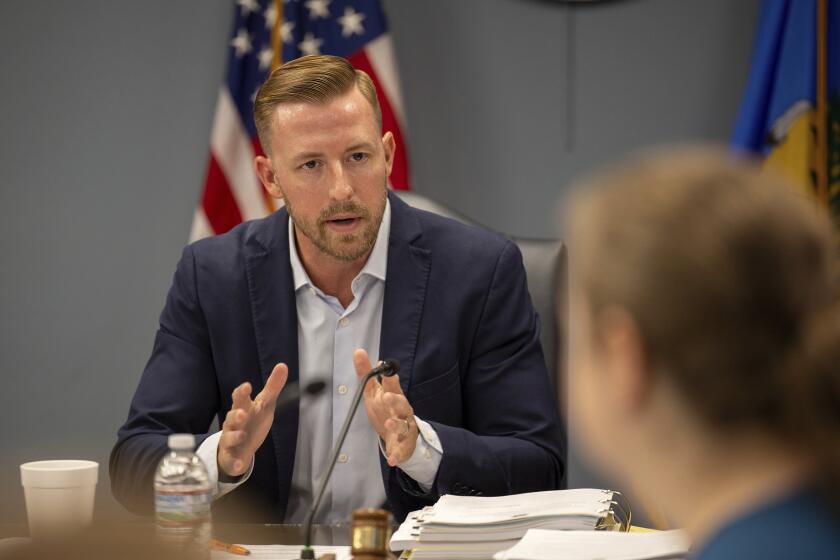Soldiers took them in the night. Now Mexico’s drug war strategy is on trial.
Reporting from Mexico City — The soldiers took them in the night.
First they came for Nitza Alvarado Espinoza and Jose Alvarado Herrera. The 31-year-old cousins were sitting in a van outside a family member’s house when troops forced them into a military truck.
Minutes later, soldiers arrived at the house of another Alvarado cousin, 18-year-old Rocio Alvarado Reyes. She was carried away screaming at gunpoint in front of her young brothers and baby daughter.
It was Dec. 29, 2009 — the last time the cousins were seen alive.
Exactly what happened to the working-class family from Ejido Benito Juarez, a dusty town in the northern Mexican state of Chihuahua, is the subject of a landmark case that will be heard beginning Thursday by the Inter-American Court of Human Rights.
It is the first case related to Mexico’s drug war to come before the court, part of the human rights protection arm of the Organization of American States. The court is expected to rule that Mexico is guilty of human rights violations for failing to bring justice in the case and require the government to make reparations to the victims’ family.
Legal analysts say it is not only Mexico’s government that will be on trial, but also the country’s broader strategy of using soldiers to fight domestic crime — a controversial tactic that is gaining popularity across Latin America, notably in Brazil, Honduras, El Salvador and Venezuela.
In the more than 11 years since Mexico sent tens of thousands of army and navy personnel into the streets to battle increasingly powerful drug cartels, the armed forces have faced repeated accusations of torture, illegal arrests and extrajudicial killings. They have operated with near impunity: Between 2012 and 2016, just 3% of investigations into crimes allegedly committed by soldiers resulted in convictions, according to an analysis by the think tank Washington Office on Latin America, or WOLA.
Despite international objections, Mexico’s Congress recently passed a measure, known as the Internal Security Law, that further cements the role of the armed forces in preserving public security and expands their powers of surveillance.
As Mexico’s Supreme Court weighs challenges to the constitutionality of that law, human rights advocates are hoping that the Inter-American Court will use the Alvarado case to demand justice for the family and deliver a strong rebuke of the security law. Rulings issued by the Inter-American Court, based in Costa Rica, are legally binding in Mexico, and the court’s opinion on the law could influence the Supreme Court.

“The Alvarado case provokes discussion about what is wrong about the armed forces being in charge of public security,” said Alberto Abad Suarez, with the Legal Research Institute at the National Autonomous University of Mexico. “There is a lot of concern across the region that the Mexico model could spread, so [the court] might want to try to stop it.”
Proponents of deploying the armed forces to dowork traditionally reserved for police say the movewas a necessary response to rising crime and undertrained and corrupt local law enforcement agencies. Critics say this militarized approach has come at the expense of strengthening civilian institutions, such as the police and the Mexican attorney general’s office, and has led to increased violence.
“Soldiers are not trained as policemen; they are trained to participate in armed conflicts,” Abad said.
Homicides have more than doubled since then-President Felipe Calderon launched Mexico’s war on drugs in late 2006, sending 6,500 troops into his home state of Michoacan. That year, Mexican prosecutors opened 11,806 homicide investigations, according to government data. Last year, they opened 25,340.
Disappearances — abductions of individuals by criminals, state agents or others — are also up. The number of people “disappeared” nationwide was more than 30,000 last year, up from 26,000 in 2013, according to Mexico’s National Human Rights Commission. The victims are found, either dead or alive, less than 25% of the time, leaving grieving mothers and fathers to comb the earth for the remains of their loved ones in hidden graves.
The government blames criminal groups for the vast majority of Mexico’s disappearances. But an analysis of 548 disappearances between 2005 and 2015 by the Observatory on Disappearances and Impunity in Mexico found that federal, state and municipal authorities were the perpetrators 47% of the time. The observatory is an effort launched by Oxford University, the University of Minnesota and the Latin American Social Sciences Institute.
Relatives of the missing Alvarado cousins brought their case to the Inter-American Commission on Human Rights in 2011, saying they had exhausted remedies in Mexico’s judicial system. In 2014, the commission found that the army was responsible and instructed Mexico to bring the perpetrators to justice.
Two years later, the commission referred the case to the Inter-American Court after it determined that Mexico had not complied with its recommendations. A report submitted to the court by the commission spells out what is known about what happened to the cousins that chilly night in 2009.
After a federal police officer was killed in Ejido Benito Juarez and several other law enforcement officials went missing, about 500 federal troops were dispatched to investigate. What resulted was a reign of terror. Soldiers kidnapped and tortured residents for information, the report says. Most were then set free.
Family members of the cousins say they have been given no explanation about why the three disappeared. The only sign that they might still be alive came in February 2010, when the family received a phone call believed to be from a penitentiary in Mexico City. It was Nitza Alvarado Espinoza.
“Help me, get me out of here,” she pleaded, according to the family. “I’m alive and I’m scared.”
Officials failed to track the call, and investigations stalled. The cousins’ relatives said they received threats from the army because they refused to give up on the case. Several of them eventually sought political asylum in the United States. In El Paso, Nitza Alvarado’s three daughters formed an advocacy group called Children of the Disappeared.

The Mexican army did not respond to requests for comment. In its report, the human rights commission said Mexican officials insist they are making an effort to find the victims and punish the perpetrators. The government has obtained testimony from more than 100 law enforcement officials and others and believes “it can’t be concluded that state actors were involved,” the report said.
Mexico’s armed forces are facing increasing outside scrutiny. Hundreds of human rights groups implored lawmakers to reject the Internal Security Law, with the United Nations high commissioner for human rights warning that the measure gives too much power to the military without the necessary civilian checks and balances.
Mexico’s military has used the media to defend its role in fighting crime, and the effort appears to be succeeding. In polls, Mexicans say they trust the army more than police to protect civilians. The armed forces spent about $28 million on television, radio and other publicity campaigns between between 2013 and 2017, according to an analysis by Fundar, a transparency group.
How the Mexican government reacts to the courtruling “will demonstrateits level of commitment to bring justice to the victims after failing to do so for almost a decade,” said Maureen Meyer, an expert at WOLA. There are few ways to enforce compliance with the court’s judgments, she said.
Stephanie Brewer, an attorney who helped bring another case against the Mexican government before the Inter-American Court, and who was targeted by the government in a high-profile spying scandal, said there is at least one clear outcome of court proceedings: Relatives of victims are given a chance to be heard.
“When you’re being criminalized and stigmatized at home, that’s also an important element,” she said. “For victims, it’s the first time they have their day in court.”
To read this article in Spanish, click here
Twitter: @katelinthicum
More to Read
Sign up for Essential California
The most important California stories and recommendations in your inbox every morning.
You may occasionally receive promotional content from the Los Angeles Times.










